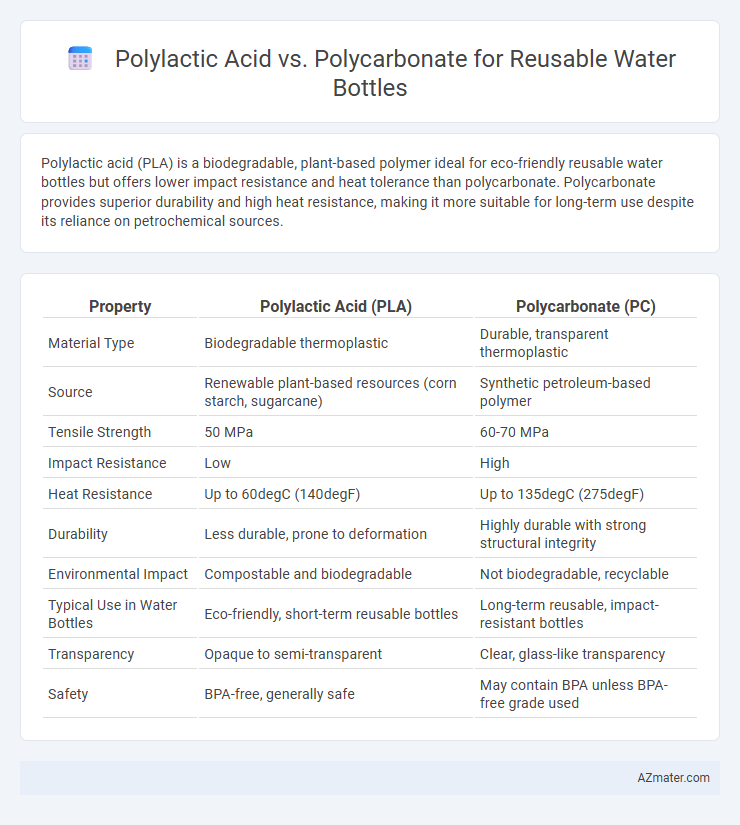Polylactic acid (PLA) is a biodegradable, plant-based polymer ideal for eco-friendly reusable water bottles but offers lower impact resistance and heat tolerance than polycarbonate. Polycarbonate provides superior durability and high heat resistance, making it more suitable for long-term use despite its reliance on petrochemical sources.
Table of Comparison
| Property | Polylactic Acid (PLA) | Polycarbonate (PC) |
|---|---|---|
| Material Type | Biodegradable thermoplastic | Durable, transparent thermoplastic |
| Source | Renewable plant-based resources (corn starch, sugarcane) | Synthetic petroleum-based polymer |
| Tensile Strength | 50 MPa | 60-70 MPa |
| Impact Resistance | Low | High |
| Heat Resistance | Up to 60degC (140degF) | Up to 135degC (275degF) |
| Durability | Less durable, prone to deformation | Highly durable with strong structural integrity |
| Environmental Impact | Compostable and biodegradable | Not biodegradable, recyclable |
| Typical Use in Water Bottles | Eco-friendly, short-term reusable bottles | Long-term reusable, impact-resistant bottles |
| Transparency | Opaque to semi-transparent | Clear, glass-like transparency |
| Safety | BPA-free, generally safe | May contain BPA unless BPA-free grade used |
Introduction to Polylactic Acid and Polycarbonate
Polylactic acid (PLA) is a biodegradable thermoplastic derived from renewable resources like corn starch and sugarcane, widely used for eco-friendly water bottles due to its compostability and low environmental impact. Polycarbonate (PC) is a durable, transparent plastic known for its high impact resistance, temperature tolerance, and long-lasting durability, commonly employed in reusable water bottles for strength and clarity. Comparing PLA and polycarbonate provides insight into sustainability, safety, and performance factors essential for selecting materials in reusable water bottle manufacturing.
Material Composition and Origins
Polylactic acid (PLA) is a biodegradable thermoplastic derived from renewable resources such as corn starch or sugarcane, offering an eco-friendly alternative to conventional plastics. Polycarbonate (PC) is a durable, transparent polymer synthesized from bisphenol A (BPA) and phosgene, known for its high impact resistance and heat tolerance. PLA's plant-based origins contribute to its compostability, whereas polycarbonate's petroleum-based composition provides greater structural strength and longevity in reusable water bottles.
Environmental Impact and Sustainability
Polylactic acid (PLA) is a biodegradable polymer derived from renewable resources like corn starch, offering a lower carbon footprint compared to polycarbonate, which is petroleum-based and non-biodegradable. PLA decomposes under industrial composting conditions, reducing landfill waste and microplastic pollution, whereas polycarbonate poses environmental concerns due to its long degradation time and potential release of bisphenol A (BPA). Choosing PLA for reusable water bottles supports circular economy principles by enhancing sustainability through renewable sourcing and improved end-of-life disposal options.
Durability and Longevity
Polylactic acid (PLA), derived from renewable resources, offers biodegradability but generally lacks the high durability required for long-term use in reusable water bottles, showing susceptibility to cracking and deformation under stress. Polycarbonate, a durable thermoplastic polymer, provides superior impact resistance and longevity, maintaining structural integrity over extended periods, making it a preferred choice for robust reusable bottles. The longevity of polycarbonate bottles outweighs PLA's environmental benefits when durability and repeated use are critical factors.
Safety and Health Concerns
Polylactic acid (PLA) is derived from renewable resources like corn starch and is generally considered non-toxic and safe for reusable water bottles, with low risk of harmful chemical leaching. Polycarbonate, while durable and clear, contains bisphenol A (BPA), a chemical linked to hormone disruption and other health concerns, raising safety issues especially with prolonged use and high temperatures. Choosing PLA offers safer health benefits due to its biodegradable nature and lower chemical risks compared to BPA-containing polycarbonate bottles.
Thermal Resistance Performance
Polylactic acid (PLA) exhibits lower thermal resistance, typically with a heat deflection temperature around 55-60degC, making it less suitable for hot liquids in reusable water bottles. Polycarbonate (PC) demonstrates superior thermal resistance, withstanding temperatures up to 135degC, ensuring durability and safety when exposed to hot beverages. The higher thermal stability of polycarbonate significantly reduces deformation and leaching risks during repeated use with hot or warm water.
Weight and Handling Comfort
Polylactic acid (PLA) water bottles are significantly lighter than polycarbonate (PC) ones, enhancing portability and ease of use during activities like hiking or commuting. PLA's lightweight nature contributes to better handling comfort, reducing user fatigue over extended periods. Polycarbonate bottles, while more durable, often feel heavier and can be less comfortable to carry for long durations due to their density.
Cleaning and Maintenance Considerations
Polylactic acid (PLA) water bottles require gentle cleaning methods as they are sensitive to high temperatures and harsh detergents, which can cause warping or degradation over time. Polycarbonate bottles offer superior durability and resistance to repeated washing cycles, making them easier to maintain and more suitable for dishwasher cleaning. Users should avoid abrasive scrubbers on PLA bottles to preserve the material's integrity, while polycarbonate withstands rigorous cleaning without compromising bottle structure or safety.
Cost and Market Availability
Polylactic acid (PLA) is generally more cost-effective than polycarbonate (PC) due to its bio-based origins and simpler production process, making it a popular choice for eco-friendly reusable water bottles. Polycarbonate offers superior durability and clarity but comes at a higher price point, limiting its widespread market availability primarily to premium segments. PLA's growing adoption is driven by increased demand for sustainable materials, supported by expanding production capacity and competitive pricing in the global market.
Conclusion: Choosing the Right Material
Polylactic acid (PLA) offers a biodegradable and eco-friendly alternative to polycarbonate (PC), making it suitable for consumers prioritizing sustainability in reusable water bottles. Polycarbonate provides superior durability, heat resistance, and impact strength, ideal for long-term use and varied environmental conditions. Selecting the right material depends on balancing environmental impact with performance needs, where PLA suits low-impact usage and polycarbonate excels in toughness and longevity.

Infographic: Polylactic acid vs Polycarbonate for Reusable Water Bottle
 azmater.com
azmater.com